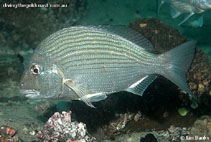Rhabdosargus sarba (Forsskål, 1775)
Goldlined seabream
Add your observation in Fish Watcher
| Native range | All suitable habitat | Point map | Year 2050 |

|
| This map was computer-generated and has not yet been reviewed. |
| Rhabdosargus sarba AquaMaps Data sources: GBIF OBIS |
Saudi Arabia country information
Common names:
[No common name]
Occurrence: native
Salinity: brackish
Abundance: | Ref:
Importance: | Ref:
Aquaculture: commercial | Ref: FAO, 1997
Regulations: | Ref:
Uses: no uses
Comments:
National Checklist:
Country Information: https://www.cia.gov/library/publications/resources/the-world-factbook/geos/sa.html
National Fisheries Authority:
Occurrences: Occurrences Point map
Main Ref: Bauchot, M.-L. and M.M. Smith, 1984
National Database:
Occurrence: native
Salinity: brackish
Abundance: | Ref:
Importance: | Ref:
Aquaculture: commercial | Ref: FAO, 1997
Regulations: | Ref:
Uses: no uses
Comments:
National Checklist:
Country Information: https://www.cia.gov/library/publications/resources/the-world-factbook/geos/sa.html
National Fisheries Authority:
Occurrences: Occurrences Point map
Main Ref: Bauchot, M.-L. and M.M. Smith, 1984
National Database:
Common names from other countries
Classification / Names Common names | Synonyms | Catalog of Fishes(genus, species) | ITIS | CoL | WoRMS | Cloffa
Teleostei (teleosts) > Eupercaria/misc (Various families in series Eupercaria) > Sparidae (Porgies)
Etymology: Rhabdosargus: Greek, rhabdos = stick + Latin, sargus = sargus (1591) (Ref. 45335).
More on author: Forsskål.
Etymology: Rhabdosargus: Greek, rhabdos = stick + Latin, sargus = sargus (1591) (Ref. 45335).
More on author: Forsskål.
Environment: milieu / climate zone / depth range / distribution range Ecology
Marine; brackish; reef-associated; oceanodromous (Ref. 51243); depth range 0 - 60 m (Ref. 30573). Tropical; 36°N - 38°S, 19°E - 155°E (Ref. 57004)
Distribution Countries | FAO areas | Ecosystems | Occurrences | Point map | Introductions | Faunafri
Indo-West Pacific: Red Sea and East Africa to Japan, China, and Australia.
Length at first maturity / Size / Weight / Age
Maturity: Lm 23.7 range ? - ? cm
Max length : 80.0 cm TL male/unsexed; (Ref. 3678); common length : 45.0 cm TL male/unsexed; (Ref. 1724); max. published weight: 12.0 kg (Ref. 1724)
Max length : 80.0 cm TL male/unsexed; (Ref. 3678); common length : 45.0 cm TL male/unsexed; (Ref. 1724); max. published weight: 12.0 kg (Ref. 1724)
Short description Identification keys | Morphology | Morphometrics
Dorsal spines (total): 11; Dorsal soft rays (total): 12 - 13; Anal spines: 3; Anal soft rays: 10 - 11. Bright yellow mark above the pelvic base.
Inhabit coastal waters (Ref. 30573, 44894), usually entering estuaries (Ref. 44894). Abundant in shallow water and often caught at the surf-line or in rock pools (Ref. 9987). Larger, solitary fish sometimes enter brackish mangrove areas (Ref. 9987). Juveniles in estuaries move into deeper water with growth (Ref. 4335). Often in schools (Ref. 9710). Feed on benthic invertebrates, mainly mollusks (Ref. 5213) and aquatic macrophytes (Ref. 26055). Popular angling species commonly captured with hook and line (Ref. 44894). Marketed fresh (Ref. 5284).
Life cycle and mating behavior Maturity | Reproduction | Spawning | Eggs | Fecundity | Larvae
Normally sexes are separate but some individuals are protandrous due to geographical variation in sexual pattern (Ref. 103751). Gonochorism is confirmed in Australia, and protandry in Asia (Ref. 103751). Also Ref. 28504.
Main reference
Upload your references | References | Coordinator | Collaborators
Bauchot, M.-L. and M.M. Smith, 1984. Sparidae. In W. Fischer and G. Bianchi (eds.) FAO species identification sheets for fishery purposes. Western Indian Ocean (Fishing Area 51). volume 4. [var. pag.] FAO, Rome. (Ref. 3507)
IUCN Red List Status (Ref. 130435: Version 2024-2)
Least Concern (LC) ; Date assessed: 02 December 2009
Threat to humans
Harmless
Human uses
Fisheries: commercial; aquaculture: commercial; gamefish: yes
FAO(Aquaculture systems: production; ; publication : search) | FishSource | Sea Around Us
More information
Population dynamics
Growth parameters
Max. ages / sizes
Length-weight rel.
Length-length rel.
Length-frequencies
Mass conversion
Recruitment
Abundance
Growth parameters
Max. ages / sizes
Length-weight rel.
Length-length rel.
Length-frequencies
Mass conversion
Recruitment
Abundance
Life cycle
Reproduction
Maturity
Fecundity
Spawning
Spawning aggregations
Eggs
Egg development
Larvae
Larval dynamics
Reproduction
Maturity
Fecundity
Spawning
Spawning aggregations
Eggs
Egg development
Larvae
Larval dynamics
Physiology
Body composition
Nutrients
Oxygen consumption
Swimming type
Swimming speed
Visual pigments
Fish sound
Diseases & Parasites
Toxicity (LC50s)
Body composition
Nutrients
Oxygen consumption
Swimming type
Swimming speed
Visual pigments
Fish sound
Diseases & Parasites
Toxicity (LC50s)
Human related
Aquaculture systems
Aquaculture profiles
Strains
Ciguatera cases
Stamps, coins, misc.
Aquaculture systems
Aquaculture profiles
Strains
Ciguatera cases
Stamps, coins, misc.
Tools
E-book | Field guide | Identification keys | Length-frequency wizard | Life-history tool | Point map | Classification Tree
| Catch-MSY |
Special reports
Download XML
Internet sources
Aquatic Commons | BHL | Cloffa | BOLDSystems | Websites from users | Check FishWatcher | CISTI | Catalog of Fishes(genus, species) | DiscoverLife | ECOTOX | Faunafri | Fishtrace | GenBank(genome, nucleotide) | GloBI | GOBASE | | Google Books | Google Scholar | Google | IGFA World Record | MitoFish | National databases | Otolith Atlas of Taiwan Fishes | PubMed | Reef Life Survey | Scirus | SeaLifeBase | Tree of Life | Wikipedia(Go, Search) | World Records Freshwater Fishing | Zoological Record
Estimates based on models
Preferred temperature (Ref. 115969): 21.9 - 29, mean 28 (based on 1662 cells).
Phylogenetic diversity index (Ref. 82804): PD50 = 0.5156 [Uniqueness, from 0.5 = low to 2.0 = high].
Bayesian length-weight: a=0.01995 (0.01666 - 0.02389), b=2.96 (2.91 - 3.01), in cm Total Length, based on LWR estimates for this species (Ref. 93245).
Trophic level (Ref. 69278): 3.3 ±0.47 se; based on food items.
Resilience (Ref. 120179): Medium, minimum population doubling time 1.4 - 4.4 years (Assuming tm=2-4).
Fishing Vulnerability (Ref. 59153): Moderate vulnerability (36 of 100).
Climate Vulnerability (Ref. 125649): Very high vulnerability (88 of 100).




